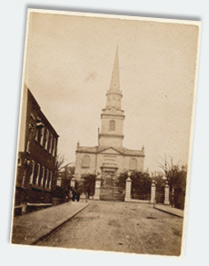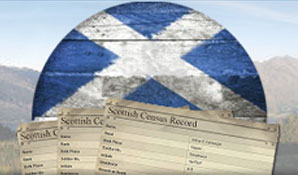Family History Guide
Articles
Introduction
There is so much genealogical information available in archives, in Britain and abroad, that only a small percentage of this appears anywhere on the Internet. Amongst the many other genealogical records that you can use are wills, manorial records, occupational records of all sorts, military service records, records of the merchant navy and much more. These are all covered in Anthony Adolph's book Tracing Your Family History (Collins, revised edition, 2008).
How do I trace back before the censuses?
Assuming your journey back through the censuses and General Registration records of birth, marriage death went well, then the place where you are most likely to get stuck is just before they began – 1837 for General Registration and 1841 for censuses. In general, the main records for tracing further back than this are parish registers. Simply understanding what parish registers are and how they work will often be enough to get you back on track again. You may be able to use Genes Reunited family trees, submitted to the site by members, in order to find relations born before 1837. Search trees for your relations here.
How can I use parish registers?

Historically, England and Wales was divided into about 11,000 parishes. You can learn more about these at www.visionofbritain.org.uk and www.genuki.org.uk. Henry VIII decreed that each parish should keep registers of the baptisms, marriages and burials of its inhabitants from 1538 onwards. In reality, few survive before 1558, when they started being kept on durable sheepskin, not paper, but even then few survive before the 1600s.
From 1598, annual copies were made and sent to the local bishop Called Bishops' Transcripts (or Register Bills in East Anglia), these make a good substitute for lost original records, and occasionally contain information omitted from the registers themselves. They can be found in county record offices.
Initially, you may be disappointed to find that parish registers are less detailed than General Registration records. Britain's parish registers are amongst the very best in the world in terms of detail, survival and accessibility.
Most parish registers are now deposited in county archives. You can find archives through www.a2a.org.uk and The Family and Local History Handbook (published by Robert Blatchford). An essential book is The Phillimore Atlas and Index of Parish Registers, Phillimore (rev. edn 2003), which lists the basic coverage dates of the registers, whether they are covered by indexes, and includes indispensable maps of each county showing the parish boundaries.
Many parish registers have been indexed on-line, particularly in the formidable International Genealogical Index (IGI), compiled by the Mormon Church, and available, free, at www.familysearch.org. Another very useful site for parish registers is http://freereg.rootsweb.com/.
Therefore, you have several options when you get back to 1837/1841. The censuses will tell you where your ancestors were born before 1837, so you can turn to the relevant parish register and start searching for baptisms. Or, you can search in the parish register indexes, and see if these will reveal likely baptisms for your ancestors, before you start using the original records.
Note that census returns say where people were born (or thought they were born!), whereas parish registers record where people were baptized. These events, though they often happened close together in time and place, are not the same. Baby Tom may have been born in Chertsey, Surrey, on 2 April and baptized at Chertsey parish church the day afterwards. But his mother may have given birth in Chertsey, prematurely on a journey from London back to her home village in Wiltshire, and it will be there, maybe many months later, and not in Chertsey, that Tom was actually baptized. If Tom's baptism appears in an index, such as the IGI (The International Genealogical Index), you stand a better chance of finding it. There are not always easy answers: tracing back before 1837/41 can involve a great deal of ingenuity and a fair bit of guesswork as well!
Please remember that indexes are secondary sources, compiled from original records, usually long after the events themselves took place. There is no such thing as a complete index, or an error-free one. If you don't find what you expect in an index, it does not mean that the event you want is not in the original records that the index supposedly covers. An entry taken from an index is very useful as a means of going to and examining an original record but it is not a valid piece of evidence in its own right. If possible, always check the original registers.
Having established which archive you need, check opening times and booking requirements, and what identification you need to take. Go armed with a pencil, as pens can harm original records. Besides parish registers, you will find a plethora of other wonderful local sources that will help you. If it is too far for you to travel to an archive, hire a genealogist to go instead, or you can order microform copies of many to your local Mormon Family History Centre (see www.familysearch.org). The Society of Genealogists in London (www.sog.org.uk) has a large collection of transcriptions of original registers (which vary in quality depending on who made them).
How will I know I have found the correct entry?
This is one of the most frequently asked questions, and one of the hardest to answer. Parish registers were created in order to work out who was related to whom: one of the prime reasons for this was to prevent close relations from marrying each other.
Success depends on making thorough, broad searches, to pick up all possibilities; making intelligent assumptions on what relationships were likely to have been; trying to disprove your own theories and, wherever possible, using other sources to back up your assumptions. For example, say you are looking for the baptism of John Smith, who married in 1750. Until 1929, provided they had parental consent, boys could marry at 14 and girls at 12 (and after 1929 the minimum age for both was 16). If a search of the baptisms from about 1736 back to 1700 reveals only one John Smith baptism, in 1730, then you can work on the reasonable assumption that this is the one who married in 1750. You can try to prove yourself wrong by searching the burials, which may show that the 1730 John was buried as an infant (infant burials are usually identified as such), thus ruling him out, or maybe you will find the burial of your John in 1780, but aged 75, not 50. If you prove, thus, that the 1730 baptism is not for your John, you can extend the search to other neighbouring parishes.
The other main problem likely to arise, though, is finding more than one John Smith baptized in the parish. But again, hopefully, you will be able to rule one out, and find some additional data, such as an age at burial, that will confirm the other one to be yours. There are cases, however, especially when two or more people of the same name were baptized in a short period of time, that it becomes impossible to work out which was right, and which wrong. In these cases, sometimes the best policy is to trace the ancestry of both, and hope that they came from the same ancestors.
This slightly complicated example is to reassure you that parish register work does not always produce complete certainty, and requires making some assumptions. As you gain more experience, you will get better at this. Further sources that you will find in the record offices, that you can research and bring into play here, can include settlement certificates (that record where incomers to a parish came from); wills (that name beneficiaries who were generally children and grandchildren); manorial records (that show how small pieces of land were inherited through successive generations of the same family), and many forms of records relating to what people did (soldiers' records, for example, often state when and where they were born).
One key point to remember is this – if you're not certain of a link, make this clear, keep on researching, and later on, perhaps with the help of other members of Genes Reunited, you may be able to come back with more evidence and provide the better proof you need. Anthony Adolph's book Tracing Your Family History (Collins) explains more, and if you want to learn the subject in depth, explore the courses and talks offered by the Society of Genealogists (www.sog.org.uk) and the Institute of Heraldic and Genealogical Studies (www.ihgs.ac.uk).

